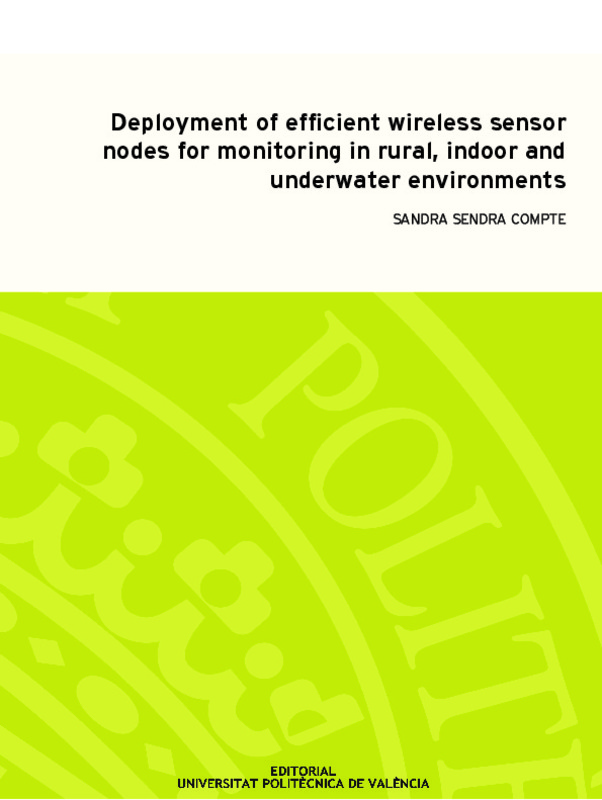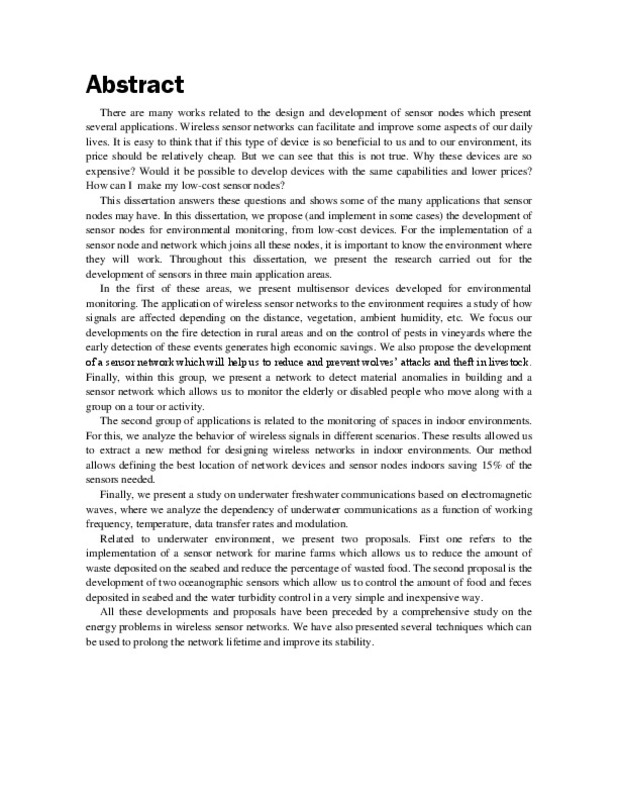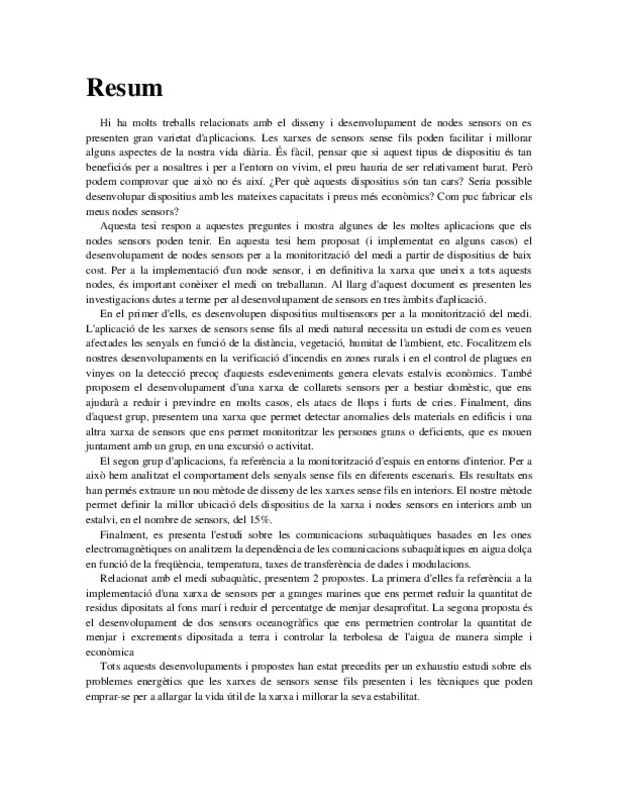- RiuNet repositorio UPV
- :
- Investigación
- :
- Tesis doctorales
- :
- Ver ítem
JavaScript is disabled for your browser. Some features of this site may not work without it.
Buscar en RiuNet
Listar
Mi cuenta
Estadísticas
Ayuda RiuNet
Admin. UPV
Deployment of Efficient Wireless Sensor Nodes for Monitoring in Rural, Indoor and Underwater Environments
Mostrar el registro sencillo del ítem
Ficheros en el ítem
| dc.contributor.advisor | Ardid Ramírez, Miguel
|
es_ES |
| dc.contributor.advisor | Lloret Mauri, Jaime
|
es_ES |
| dc.contributor.author | Sendra Compte, Sandra
|
es_ES |
| dc.date.accessioned | 2013-09-23T06:27:58Z | |
| dc.date.available | 2013-09-23T06:27:58Z | |
| dc.date.created | 2013-09-06T14:00:35Z | es_ES |
| dc.date.issued | 2013-09-23T06:27:56Z | es_ES |
| dc.identifier.isbn | 978-84-9048-135-6 | |
| dc.identifier.uri | http://hdl.handle.net/10251/32279 | |
| dc.description.abstract | Existen muchos trabajos relacionados con el diseño y desarrollo de nodos sensores, donde se presentan gran variedad de aplicaciones. Las redes de sensores inalámbricos pueden facilitarnos y mejorar algunos aspectos de nuestra vida diaria. Es fácil, pensar que si este tipo de dispositivo es tan beneficioso para nosotros y para el entorno donde vivimos, su precio debería ser relativamente barato. Pero podemos comprobar que esto no es así. ¿Por qué estos dispositivos son tan caros? ¿Sería posible desarrollar dispositivos con las mismas capacidades y precios más económicos? ¿Cómo puedo fabricar mis nodos sensores de bajo coste? Esta tesis responde a estas preguntas y muestra algunas de las muchas aplicaciones que los nodos sensores pueden tener. En esta tesis hemos propuesto (e implementado en algunos casos) el desarrollo de nodos sensores para la monitorización del medio, a partir de dispositivos de bajo coste. Para la implementación de un nodo sensor, y en definitiva la red que une a todos estos nodos, es importante conocer el medio donde trabajarán. A lo largo de este documento se presentan las investigaciones llevadas a cabo para el desarrollo de sensores en tres ámbitos de aplicación. En el primero de ellos, se desarrollan dispositivos multisenores para la monitorización del medio. La aplicación de las redes de sensores inalámbricas al medio natural, precisa un estudio de cómo se ven afectadas las señales, en función de la distancia, vegetación, humedad del ambiente, etc. Focalizamos nuestros desarrollos en la verificación de incendios en zonas rurales y en el control de plagas en viñedos donde la detección precoz de estos eventos genera elevados ahorros económicos. También proponemos el desarrollo de una red de collares sensores para ganado domestico, que nos ayudará a reducir y prevenir en muchos casos, los ataques de lobos y hurtos de crías. Por último, dentro de este grupo, presentamos una red permite detectar anomalía de los materiales en edificios y red de sensores que nos permite monitorizar las personas mayores o deficientes, que se mueven junto con un grupo, en una excursión o actividad. El segundo grupo de aplicaciones, hace referencia a la monitorización de espacios en entornos de interior. Para ello hemos analizado el comportamiento de las señales inalámbricas en diferentes escenarios. Los resultados, nos han permitido extraer un nuevo método de diseño de las redes inalámbricas en interiores. Nuestro método, permite definir la mejor ubicación de los dispositivos de red y nodos sensores en interiores con un ahorro en el número de sensores del 15%. Por último, se presenta el estudio sobre las comunicaciones subacuáticas basadas en las ondas electromagnéticas donde analizamos la dependencia de las comunicaciones subacuáticas en agua dulce en función de la frecuencia, temperatura, tasas de transferencia de datos y modulación. Relacionado con el medio subacuático, presentamos 2 propuestas. La primera de ellas hace referencia a la implementación de una red de sensores para granjas marinas que nos permite reducir la cantidad de residuos depositados en el lecho marino y reducir el porcentaje de comida desperdiciada. La segunda propuesta es el desarrollo de dos sensores oceanográficos que nos permitirían controlar la cantidad de comida y heces depositadas en el suelo y controlar la turbidez del agua de manera muy simple y económica Todos estos desarrollos y propuestas, han estado precedidos por un exhaustivo estudio sobre los problemas energéticos que las redes de sensores inalámbricas presentan y las técnicas que pueden emplearse, para prolongar la vida útil de la red y mejorar su estabilidad. | es_ES |
| dc.description.abstract | There are many works related to the design and development of sensor nodes which present several applications. Wireless sensor networks can facilitate and improve some aspects of our daily lives. It is easy to think that if this type of device is so beneficial to us and to our environment, its price should be relatively cheap. But we can see that this is not true. Why these devices are so expensive? Would it be possible to develop devices with the same capabilities and lower prices? How can I make my low-cost sensor nodes? This dissertation answers these questions and shows some of the many applications that sensor nodes may have. In this dissertation, we propose (and implement in some cases) the development of sensor nodes for environmental monitoring, from low-cost devices. For the implementation of a sensor node and network which joins all these nodes, it is important to know the environment where they will work. Throughout this dissertation, we present the research carried out for the development of sensors in three main application areas. In the first of these areas, we present multisensor devices developed for environmental monitoring. The application of wireless sensor networks to the environment requires a study of how signals are affected depending on the distance, vegetation, ambient humidity, etc. We focus our developments on the fire detection in rural areas and on the control of pests in vineyards where the early detection of these events generates high economic savings. We also propose the development of a sensor network which will help us to reduce and prevent wolves¿ attacks and theft in livestock. Finally, within this group, we present a network to detect material anomalies in building and a sensor network which allows us to monitor the elderly or disabled people who move along with a group on a tour or activity. The second group of applications is related to the monitoring of spaces in indoor environments. For this, we analyze the behavior of wireless signals in different scenarios. These results allowed us to extract a new method for designing wireless networks in indoor environments. Our method allows defining the best location of network devices and sensor nodes indoors saving 15% of the sensors needed. Finally, we present a study on underwater freshwater communications based on electromagnetic waves, where we analyze the dependency of underwater communications as a function of working frequency, temperature, data transfer rates and modulation. Related to underwater environment, we present two proposals. First one refers to the implementation of a sensor network for marine farms which allows us to reduce the amount of waste deposited on the seabed and reduce the percentage of wasted food. The second proposal is the development of two oceanographic sensors which allow us to control the amount of food and feces deposited in seabed and the water turbidity control in a very simple and inexpensive way. All these developments and proposals have been preceded by a comprehensive study on the energy problems in wireless sensor networks. We have also presented several techniques which can be used to prolong the network lifetime and improve its stability. | en_EN |
| dc.language | Inglés | es_ES |
| dc.publisher | Editorial Universitat Politècnica de València | es_ES |
| dc.rights | Reserva de todos los derechos | es_ES |
| dc.source | Riunet | es_ES |
| dc.subject | Wireless Sensor Networks | es_ES |
| dc.subject | Saving Energy | es_ES |
| dc.subject | Environmental Motinoring | es_ES |
| dc.subject | Sensors Location | es_ES |
| dc.subject | Underwater Communications | es_ES |
| dc.subject | Low Cost Sensor Deployment. | es_ES |
| dc.subject.classification | ELECTRONICA | es_ES |
| dc.subject.classification | TECNOLOGIA ELECTRONICA | es_ES |
| dc.subject.classification | INGENIERIA TELEMATICA | |
| dc.title | Deployment of Efficient Wireless Sensor Nodes for Monitoring in Rural, Indoor and Underwater Environments | |
| dc.type | Tesis doctoral | es_ES |
| dc.identifier.doi | 10.4995/Thesis/10251/32279 | es_ES |
| dc.rights.accessRights | Abierto | es_ES |
| dc.contributor.affiliation | Universitat Politècnica de València. Departamento de Ingeniería Electrónica - Departament d'Enginyeria Electrònica | es_ES |
| dc.description.bibliographicCitation | Sendra Compte, S. (2013). Deployment of Efficient Wireless Sensor Nodes for Monitoring in Rural, Indoor and Underwater Environments [Tesis doctoral]. Editorial Universitat Politècnica de València. https://doi.org/10.4995/Thesis/10251/32279 | es_ES |
| dc.description.accrualMethod | TESIS | es_ES |
| dc.type.version | info:eu-repo/semantics/acceptedVersion | es_ES |
| dc.relation.tesis | 7831 | es_ES |
Este ítem aparece en la(s) siguiente(s) colección(ones)
-
Tesis doctorales [5213]
-
Tesis. Editorial UPV [172]







![MS Word file [Word]](/themes/UPV/images/msword.png)




